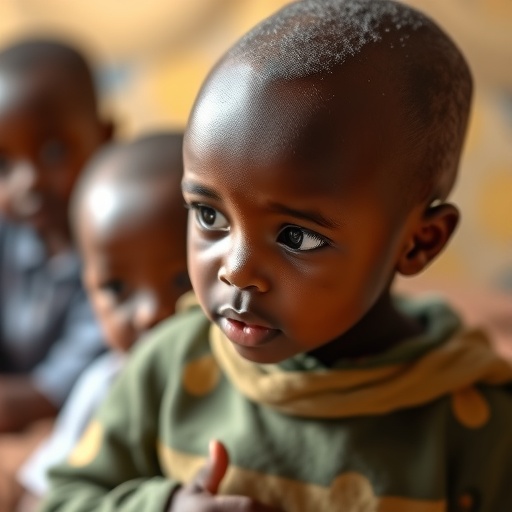In an alarming new study conducted in Jigjiga city, Somali region, Ethiopia, a comprehensive investigation has shed light on the magnitude and contributing factors of pneumonia among children under five years of age. The research, spearheaded by an accomplished team of experts, including Osman et al., delves into the staggering statistics surrounding this significant health issue. The findings are crucial, as pneumonia remains one of the leading causes of morbidity and mortality among this vulnerable age group. The research not only addresses the urgency of the problem but also offers insights into potential solutions and preventive measures.
Pneumonia in children under five is a critical public health concern, especially in low-resource settings like Jigjiga. The study reveals that a significant proportion of these children are affected, pointing to underlying issues such as poor access to healthcare, inadequate nutrition, and the prevalence of respiratory infections in the environment. The researchers meticulously collected data from outpatient departments of public hospitals in Jigjiga, serving as an essential data point for understanding the local context of pneumonia’s impact. These data collection efforts highlighted the severity of pneumonia, enabling the authors to underscore the need for targeted interventions.
One of the most striking findings of the study is the demographic analysis of affected children. The researchers broke down the incidence rates based on age, sex, and socio-economic status, revealing that certain groups are disproportionately affected. Infants and children under two years old, for example, showed a higher prevalence of pneumonia, likely due to their developing immune systems and vulnerability to infections. The data also indicated that boys are more affected than girls, prompting further investigation into potential biological and environmental factors that contribute to this discrepancy.
Socio-economic factors emerged as significant contributors to pneumonia’s prevalence in the study. Many families in the region live in poverty, which restricts their access to essential health services and clean living conditions. Poor indoor air quality, often exacerbated by the use of solid fuels for cooking and heating, was also linked to increased pneumonia rates. This finding highlights the environmental aspect of pneumonia and calls for interventions that address both healthcare access and environmental health to reduce the disease’s burden on children.
The research underscores the importance of raising awareness about pneumonia among community members and healthcare providers. Educational initiatives are necessary to inform families about the signs and symptoms of pneumonia, as timely diagnosis and treatment are critical for improving outcomes. The study advocates for the implementation of community health programs aimed at increasing public knowledge while simultaneously encouraging caregivers to seek medical attention at the onset of respiratory symptoms in their children.
Vaccination plays a pivotal role in preventing pneumonia, particularly in high-risk populations. The researchers pointed out that although vaccines for pneumonia, like the pneumococcal conjugate vaccine (PCV), have been rolled out in some regions, coverage rates in Ethiopia remain suboptimal. The study calls for increased efforts to ensure that all children receive the recommended vaccinations, as this is one of the most effective ways to reduce the incidence of pneumonia and its associated complications.
A comprehensive approach to tackling pneumonia in under-five children should also include addressing nutritional deficiencies. Malnourished children are at a significantly higher risk of developing severe pneumonia, emphasizing the need for integrated health initiatives that focus on both nutrition and infection prevention. The research highlights the critical link between food security, nutritional health, and the resilience of children’s immune systems, advocating for policies that ensure children receive adequate nutrition alongside healthcare interventions.
In addition to providing insights into the local epidemiology of pneumonia, the study contributes to the broader understanding of global child health challenges. The findings from Jigjiga may resonate with similar contexts in other low-income countries where pneumonia remains a leading cause of childhood mortality. By sharing these study outcomes on a global platform, researchers hope to encourage dialogue and collaborative efforts in combating pneumonia and enhancing child health worldwide.
To address the ongoing challenges posed by pneumonia, the study emphasizes a multi-faceted approach that includes not only healthcare providers but also governments and non-governmental organizations. Collaborative efforts can foster community engagement and mobilize resources needed to improve health systems and infrastructure. The commitment to sustainable development goals, particularly those aimed at health and well-being, can guide policies and practices that ultimately reduce the burden of pneumonia.
The implications of the study extend beyond the immediate context of Jigjiga, shedding light on essential factors that contribute to childhood pneumonia. As global health initiatives continue to evolve, the need for research-based evidence in shaping interventions cannot be overstated. This study serves as a reminder of the importance of research in informing health policy and practice, especially in resource-limited settings where every child’s life is invaluable.
In conclusion, the research led by Osman et al. paints a comprehensive picture of pneumonia’s impact on under-five children in Jigjiga city, calling for urgent action across multiple fronts. By understanding the associated factors, enhancing healthcare access, promoting vaccination, and improving nutritional status, stakeholders can work toward reducing the burden of pneumonia and ensuring healthier futures for children in Ethiopia and beyond. The study acts as a wake-up call to the global community to continue prioritizing child health and to escalate efforts to combat diseases that disproportionately affect the most vulnerable populations.
Through this research, Osman and colleagues have established a critical foundation for future studies and health interventions targeting pneumonia in children. As awareness grows and resources are allocated to combat this pervasive health issue, the hope remains that fewer children will suffer from preventable diseases like pneumonia, facilitating stronger and healthier generations to come.
Subject of Research: Pneumonia among under-five children in Jigjiga city, Somali region, Ethiopia.
Article Title: Magnitude and associated factors of pneumonia among under-five children visiting outpatient department of public hospitals in Jigjiga city, Somali region, Ethiopia in 2024.
Article References:
Osman, R.I., Ayehubizu, L.M., Muse, A.I. et al. Magnitude and associated factors of pneumonia among under-five children visiting outpatient department of public hospitals in Jigjiga city, Somali region, Ethiopia in 2024.
BMC Pediatr 25, 903 (2025). https://doi.org/10.1186/s12887-025-06270-8
Image Credits: AI Generated
DOI: https://doi.org/10.1186/s12887-025-06270-8
Keywords: pneumonia, children, health, Ethiopia, public health, nutrition, vaccination, socio-economic factors, child mortality.
Tags: access to healthcare in Jigjigachildhood respiratory infectionsJigjiga health studynutrition and pneumonia riskpneumonia in low-resource settingspneumonia morbidity and mortalityPneumonia prevalence in childrenpreventive measures for pneumoniapublic health concerns in EthiopiaSomali region pneumonia researchtargeted interventions for child healthunder-five pneumonia statistics





